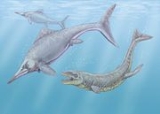
Caypullisaurus
Encyclopedia
Caypullisaurus is an extinct genus
of large ichthyosaur
from the Late Jurassic
to the Early Cretaceous
of Argentina
. Its holotype
was collected from the Vaca Muerta Formation of Cerro Lotena, Neuquen
, dating to the early Tithonian
stage of the Late Jurassic
, about 150 million years ago. Caypullisaurus was first named by Marta Fernández in 1997
and the type species
is Caypullisaurus bonapartei. It is a member of the family
Ophthalmosauridae
, and closely related to Platypterygius
and Brachypterygius
.
Genus
In biology, a genus is a low-level taxonomic rank used in the biological classification of living and fossil organisms, which is an example of definition by genus and differentia...
of large ichthyosaur
Ichthyosaur
Ichthyosaurs were giant marine reptiles that resembled fish and dolphins...
from the Late Jurassic
Late Jurassic
The Late Jurassic is the third epoch of the Jurassic Period, and it spans the geologic time from 161.2 ± 4.0 to 145.5 ± 4.0 million years ago , which is preserved in Upper Jurassic strata. In European lithostratigraphy, the name "Malm" indicates rocks of Late Jurassic age...
to the Early Cretaceous
Early Cretaceous
The Early Cretaceous or the Lower Cretaceous , is the earlier or lower of the two major divisions of the Cretaceous...
of Argentina
Argentina
Argentina , officially the Argentine Republic , is the second largest country in South America by land area, after Brazil. It is constituted as a federation of 23 provinces and an autonomous city, Buenos Aires...
. Its holotype
Holotype
A holotype is a single physical example of an organism, known to have been used when the species was formally described. It is either the single such physical example or one of several such, but explicitly designated as the holotype...
was collected from the Vaca Muerta Formation of Cerro Lotena, Neuquen
Neuquén
Neuquén is the name of the following things:* Neuquén, Argentina* Neuquén Province* Neuquén River* Neuquén Group...
, dating to the early Tithonian
Tithonian
In the geologic timescale the Tithonian is the latest age of the Late Jurassic epoch or the uppermost stage of the Upper Jurassic series. It spans the time between 150.8 ± 4 Ma and 145.5 ± 4 Ma...
stage of the Late Jurassic
Late Jurassic
The Late Jurassic is the third epoch of the Jurassic Period, and it spans the geologic time from 161.2 ± 4.0 to 145.5 ± 4.0 million years ago , which is preserved in Upper Jurassic strata. In European lithostratigraphy, the name "Malm" indicates rocks of Late Jurassic age...
, about 150 million years ago. Caypullisaurus was first named by Marta Fernández in 1997
1997 in paleontology
-newly named:-Newly named birds:-Dinosaurs:* Paleontologist Karen Chin receives a coprolite that was excavated during 1995 from strata dating back to the Maastrichtian in Saskatchewan, Canada. The specimen was about 17 inches long and contained fragments of bone...
and the type species
Type species
In biological nomenclature, a type species is both a concept and a practical system which is used in the classification and nomenclature of animals and plants. The value of a "type species" lies in the fact that it makes clear what is meant by a particular genus name. A type species is the species...
is Caypullisaurus bonapartei. It is a member of the family
Family (biology)
In biological classification, family is* a taxonomic rank. Other well-known ranks are life, domain, kingdom, phylum, class, order, genus, and species, with family fitting between order and genus. As for the other well-known ranks, there is the option of an immediately lower rank, indicated by the...
Ophthalmosauridae
Ophthalmosauridae
Ophthalmosauridae is an extinct family of thunnosaur ichthyosaurs from the Middle Jurassic to the early Late Cretaceous of Asia, Australia, Europe, North America and South America. Currently, the oldest known ophthalmosaurid is Mollesaurus from the early Bajocian of Argentina. Named by George H...
, and closely related to Platypterygius
Platypterygius
Platypterygius was an ichthyosaur of the family Ophthalmosauridae. It is most closely related to the genera Caypullisaurus and Brachypterygius.-Discovery and species:...
and Brachypterygius
Brachypterygius
Brachypterygius is a genus of ophthalmosaurid ichthyosaur known from England and European Russia. Brachypterygius was named by Friedrich von Huene in 1922 and the type species is therefore Brachypterygius extremus. The holotype of B. extremus is known from Kimmeridgian stage of the Late Jurassic of...
.

